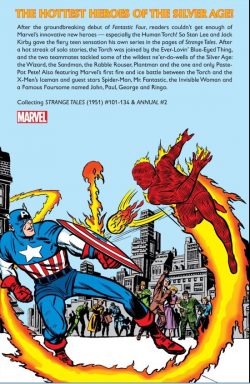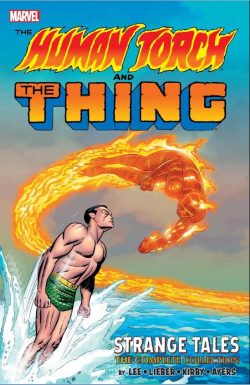

By Stan Lee, Larry Lieber, Robert Bernstein, Ernie Hart, Jerry Siegel, Larry Ivie, Jack Kirby, Dick Ayers, Bob Powell, Steve Ditko, Carl Burgos, Wallace Wood & various (Marvel)
ISBN: 978-1-3029-1334-2 (TPB)
Hot on the heels of the runaway success of Fantastic Four, Stan Lee & Jack Kirby spun the most colourful and youngest member of the team into his own series, hoping to recapture the glory of the 1940s when the Human Torch was one of the company’s “Big Three†superstars.
This captivating, esoteric and economical collection of pure 1960s superhero shenanigans gathers those eclectic but crucial yarns – no less than five major Marvel villains debuted in blistering battle against the Flaming Kid – between Strange Tales #101 – 134, as well as the lead tale from Strange Tales Annual #2 (spanning October 1962-July 1965).
Filled with fabulous classics of old school Marvel Fights ‘n’ Tights mayhem and mirth, this particular compendium (available in trade paperback and assorted eBook formats) also finally acknowledges that for a large part of that run his rocky companion and elder gadfly Ben “the Thing†Grimm was an equal player and partner in crime-busting.
Within a year of FF #1, the magic-&-monsters anthology title Strange Tales became the home for the hot-headed hero. In issue #101, teenager Johnny Storm started his ancillary solo career in the eponymous ‘The Human Torch’.
Scripted by Larry Lieber (over a plot by his brother Stan) and sublimely illustrated by Jack Kirby & Dick Ayers, here the plucky lad investigates sabotage at a new seaside amusement park and promptly discovers Commie-conniving thanks to a Red spy called the Destroyer. Kirby would pencil the first few adventures before moving on, after which inker Ayers would assume control of the series’ look for most of its run – although The King would generate some of the best covers of his Marvel career throughout the Torch’s tenure in Strange Tales.
An odd inconsistency or, more likely, tension- and drama-inducing gimmick did crop up here. Although public figures in the Fantastic Four, Johnny and his sister Sue live part-time in Long Island hamlet of Glenville and, despite the townsfolk being fully aware of her as the glamorous and heroic Invisible Girl, they seem oblivious to the fact that her baby brother is the equally famous Torch. Many daft-but-ingenious pages of Johnny protecting his secret identity would ensue before the situation was brilliantly resolved…
Although something of a hit-or-miss proposition in itself, the strip was the origin point for many of Marvel’s greatest villains. The first of these appeared in the very next issue. ‘Prisoner of the Wizard’ (Lee, Lieber, Kirby & Ayers) sees a spiteful and publicity-hungry intellectual giant determined to crush the Torch to prove his superiority to the callow kid who steals all the newspaper headlines…
The same creative team then produced captivating classic ‘Prisoner of the 5th Dimension’, as Johnny defeats an imminent invasion and frees a captive populace from tyranny before easily trashing adhesive-toting adversary ‘Paste-Pot Pete!’ (later revamped as the terrifying Trapster), before teaming with sister Sue to tackle the perilous ‘Return of the Wizard’.
When Kirby moved on to engineer and design a host of new characters and concepts (occasionally returning as necessity or special events warranted), Ayers assumed full art duties beginning with Strange Tales#106 (March 1963). This Lee & Lieber yarn was notable in that it revealed that the entire town of Glenville had always known the Torch’s secret identity but were just playing along to keep him happy…
When Acrobat Carl Zante knocks on Johnny’s door and offers him a better-paying gig in ‘The Threat of the Torrid Twosome’, the kid’s head is swelled and swayed, but he soon learns he’s been played by a master conman and diabolical bandit…
This first hint of tongue-in-cheek whimsy presaged an increasing lightness of touch which would come to characterise the Marvel style as much as the infighting between team-mates. The villainous Zante would return for another milestone in issue #114…
Issue #107 was Lieber’s last as Ayers drew a splendid punch-up with the ‘Sub-Mariner’ – a tale reminiscent of the spectacular and immensely popular Golden Age battles of their publishing forebears. Veteran writer Robert “Berns†Bernstein scripted the next two – frankly daft – sagas over Lee’s plots, but the saving grace of both ‘The Painter of a Thousand Perils!’ (empowered by an alien art kit which brought illustrations to life in ST #108) and ‘The Sorcerer and Pandora’s Box’ (#109, with monstrous demons attacking humanity) was the brief return of Kirby to the pencilling.
H.E. Huntley (Ernie Hart) typed the words for Ayers to illumine in ‘The Human Torch vs. the Wizard and Paste-Pot Pete!’: a cunning clash presaging the villains’ eventual evolution into FF’s evil counterparts the Frightful Four.
In #111 the Torch made short work of ‘Fighting to the Death with the Asbestos Man!’ – yet another demented scientist experiencing the travails and tragedies of simpler times.
Strange Tales #112 (scripted by Jerry Siegel under pen-name Joe Carter) introduced murderous electrical marauder the Eel who accidentally swiped and activated a miniature A-Bomb in tense, multifaceted thriller ‘The Human Torch Faces the Threat of the Living Bomb!‘, after which1963’s Strange Tales Annual #2, featured ‘The Human Torch on the Trail of the Amazing Spider-Man!’
This terrific romp by Lee, Kirby & Steve Ditko details how the wallcrawler is framed by international art thief The Fox, whilst back in regular comicbook Strange Tales #113, “Carter†created another long-term always-employed baddie in ‘The Coming of the Plantman!’
November’s Strange Tales #114 then changed the face of the Marvel Firmament forever…
Written by Lee himself and illustrated by Kirby & Ayers, it featured the return of the third of Timely Comics’ Golden Age Big Three – or at least an impersonation of him by the insidious Acrobat – in a blockbusting battle entitled ‘The Human Torch meets…Captain America!
Here’s a quote from the last panel…
“You guessed it! This story was really a test! To see if you too would like Captain America to Return! As usual, your letters will give us the answer!†I wonder how that all turned out?
Lee took over as scripter with ST #115’s ‘The Sandman Strikes!’ wherein Johnny impersonates Spider-Man to defeat the granular gangster Flint Marko, after which the Torrid Teen and team-mate Ben Grimm battle each other while ‘In the Clutches of the Puppet Master!’ (#116, with Ayers inked by George Roussos in his own secret identity of George Bell).
‘The Return of the Eel! proved far more of a challenge in #117, after which the Wizard has another go as ‘The Man Who Became the Torch!’, consequently nearly killing the Thing and Reed Richards besides.
A first brush with Marvel’s soon-to-be core readership came in #119. ‘The Torch Goes Wild!’ details how Commie Agent the Rabble Rouser mesmerises decent citizens, making them surly and rebellious, after which Kirby stepped back in for #120 as ‘The Torch Meets Iceman!’: a terrific action-extravaganza that pretty much ended the glory days of this strip. From then on, despite every gimmick and occasional burst of sheer inspiration, the Bullpen could muster, a slow decline set in as quirky back-up strip Doctor Strange grew in popularity – and cover space…
ST #121 saw Johnny as ‘Prisoner of the Plantman!’ (Lee & Ayers) and #122 found a thug, a conman and a yogi all augmented by Dr. Doom and mustered as the woefully lame Terrible Trio ordered to launch an ill-conceived attack in ‘3 Against the Torch!’
Strange Tales #123 has a creepy inventor build himself an impressive insectoid exo-suit to get rich the easy way, as – in an effort to boost ratings – The Thing becomes a permanent fixture in ‘The Birth of the Beetle!’
This so-so saga was most notable for the pencil job by Golden Age Torch creator Carl Burgos, after which Johnny and Ben tackle a fully re-designed ‘Paste-Pot Pete’ (inked by Paul Reinman) before going after another old adversary in ‘The Sub-Mariner Must Be Stopped!’
‘Pawns of the Deadly Duo!’ sees Puppet Master return, allied to the Mad Thinker in a clever but shallow yarn whilst #127 pits Ben and Johnny against a bizarre puzzle and ‘The Mystery Villain!’
After a stunning Kirby pin-up of the Thing, the Fantastic Two then unwillingly battle ‘Quicksilver and the Scarlet Witch’ in #128 (this one inked by Frankie Ray, AKA Frank Giacoia), as the Homo Superior siblings make an abortive first attempt to quit Magneto’s Brotherhood of Evil Mutants, after which ‘The Terrible Trio!’ once more fail to impress or assassinate our heroes…
Pop culture reeled and staggered with #130 in ‘Meet the Beatles’ (not villains, but actually some sort of popular musical combo of the times, and they actually didn’t meet them at all), although brilliant Golden Age artist Bob Powell (with inking from Chic Stone) did take over the art chores for the comedy of errors/crime caper.
Ayers returned to ink #131, the dire ‘Bouncing Ball of Doom!’ with the Mad Thinker siccing a cybernetic bowling bowl on the pair before Larry Ivie scripts a capable Space Race thriller in ‘The Sinister Space Trap!’ (inked by Mike Esposito under his Mickey DeMeo alias).
Stan Lee returned for the last two tales in ST #133 and #134; ‘The Terrible Toys’ wherein Puppet Master tries a new modus operandi and ‘The Challenge of… The Watcher!’ (inked by the majestic Wally Wood) wherein Torch and Thing are transported to legendary Camelot to battle time-reaver Kang the Conqueror, but it was clear the writer’s mind was elsewhere, most likely with the new Nick Fury, Agent of S.H.I.E.L.D. strip that would replace the FF pair from Strange Tales #135 onwards.
Wrapping up this memory lane meander are a marvellous melange of original art pages by Kirby and/or Ayers, nostalgia-invoking House Ads and a cover gallery from the 1974-75 reprint series of Golden and Silver Age Torch Tales, rendered by John Romita, Joe Sinnott, Larry Lieber, Ron Wilson, Frank Giacoia, Gil Kane, Al Milgrom &Vince Colletta, plus the Kirby/Richard Isanove paint cover from Marvel Masterworks: The Human Torch #1.
It’s interesting to note that as the parent Fantastic Four title grew in scope and quality the Human Torch’s own series diminished. Perhaps there is something to be said for concentrating one’s efforts or not overexposing your stars. What was originally a spin-off for the younger audience faded as Marvel found its voice and its marketplace, although there would be periodic efforts to reinvigorate the Torch.
Sadly, the historic value often supersedes the quality of most of these strange tales, but there’s still a good deal that’s great about this series and Costumed Drama devotees with a sense of tradition and love of fun will find this book irresistible and unmissable.
© 1962, 1963, 1964, 1965, 2018 Marvel Characters, Inc. All rights reserved.
